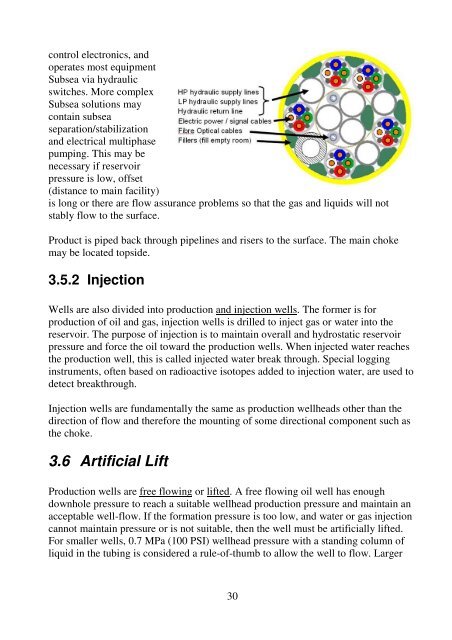Oil and gas production handbook - Process Control and ...
Oil and gas production handbook - Process Control and ...
Oil and gas production handbook - Process Control and ...
Create successful ePaper yourself
Turn your PDF publications into a flip-book with our unique Google optimized e-Paper software.
control electronics, <strong>and</strong><br />
operates most equipment<br />
Subsea via hydraulic<br />
switches. More complex<br />
Subsea solutions may<br />
contain subsea<br />
separation/stabilization<br />
<strong>and</strong> electrical multiphase<br />
pumping. This may be<br />
necessary if reservoir<br />
pressure is low, offset<br />
(distance to main facility)<br />
is long or there are flow assurance problems so that the <strong>gas</strong> <strong>and</strong> liquids will not<br />
stably flow to the surface.<br />
Product is piped back through pipelines <strong>and</strong> risers to the surface. The main choke<br />
may be located topside.<br />
3.5.2 Injection<br />
Wells are also divided into <strong>production</strong> <strong>and</strong> injection wells. The former is for<br />
<strong>production</strong> of oil <strong>and</strong> <strong>gas</strong>, injection wells is drilled to inject <strong>gas</strong> or water into the<br />
reservoir. The purpose of injection is to maintain overall <strong>and</strong> hydrostatic reservoir<br />
pressure <strong>and</strong> force the oil toward the <strong>production</strong> wells. When injected water reaches<br />
the <strong>production</strong> well, this is called injected water break through. Special logging<br />
instruments, often based on radioactive isotopes added to injection water, are used to<br />
detect breakthrough.<br />
Injection wells are fundamentally the same as <strong>production</strong> wellheads other than the<br />
direction of flow <strong>and</strong> therefore the mounting of some directional component such as<br />
the choke.<br />
3.6 Artificial Lift<br />
Production wells are free flowing or lifted. A free flowing oil well has enough<br />
downhole pressure to reach a suitable wellhead <strong>production</strong> pressure <strong>and</strong> maintain an<br />
acceptable well-flow. If the formation pressure is too low, <strong>and</strong> water or <strong>gas</strong> injection<br />
cannot maintain pressure or is not suitable, then the well must be artificially lifted.<br />
For smaller wells, 0.7 MPa (100 PSI) wellhead pressure with a st<strong>and</strong>ing column of<br />
liquid in the tubing is considered a rule-of-thumb to allow the well to flow. Larger<br />
30
















